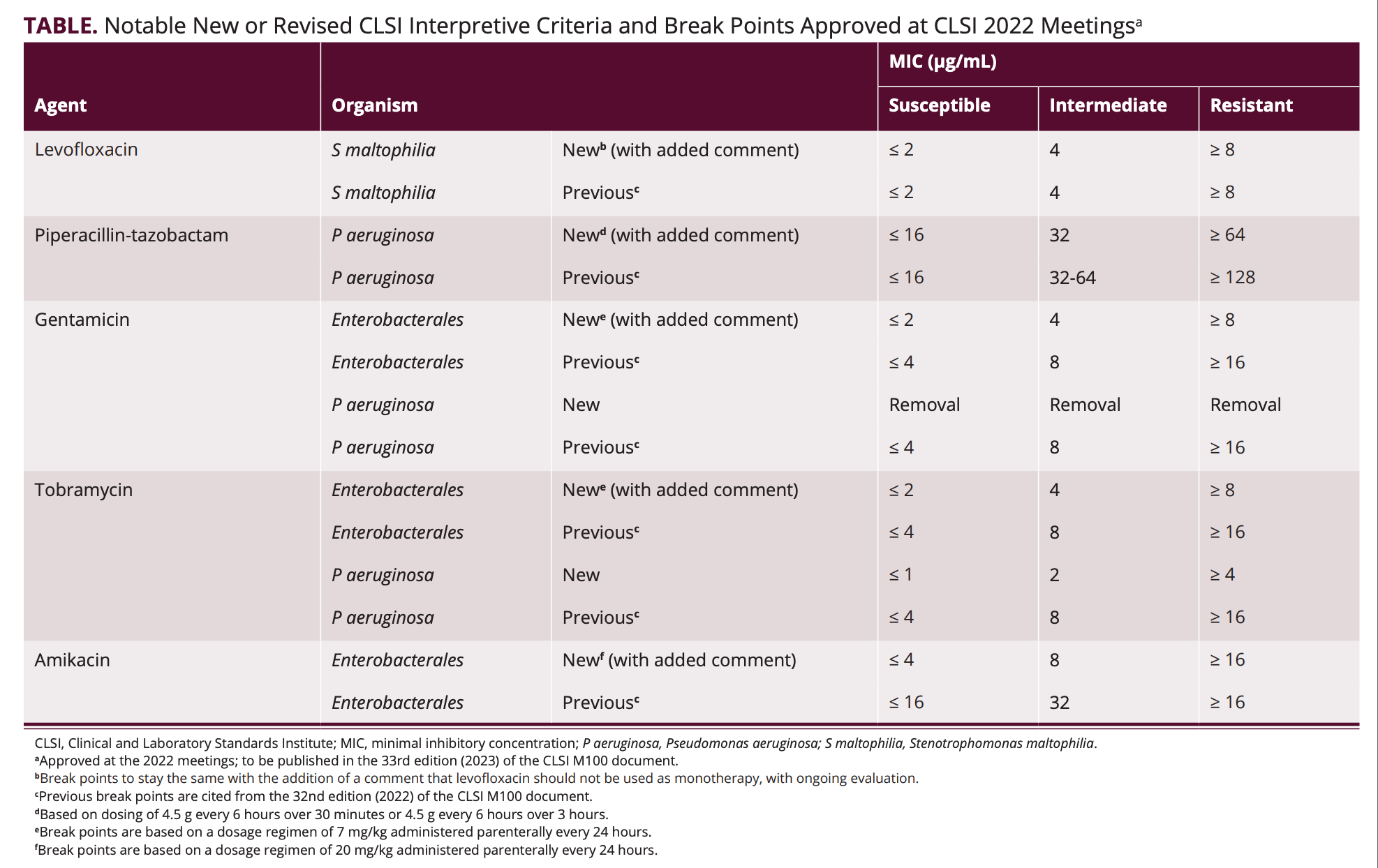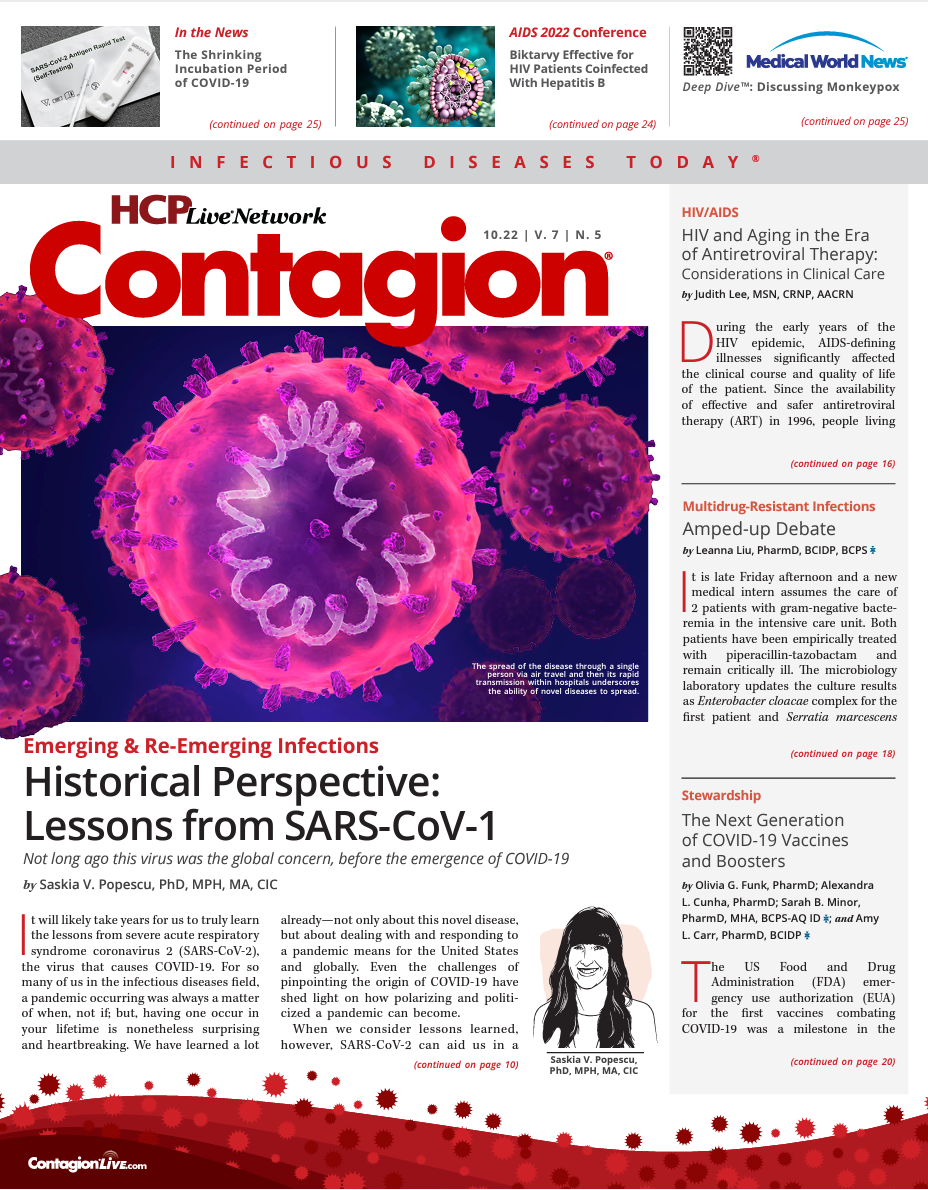What’s New in 2022 From the CLSI Subcommittee on Antimicrobial Susceptibility Testing
The Clinical and Laboratory Standards Institute Subcommittee on Antimicrobial Susceptibility Testing held a virtual winter meeting and a hybrid summer meeting in 2022. Ad hoc working groups have several breakpoint revisions underway for multiple organism-drug combinations.
REVISED BREAKPOINTS
Piperacillin-tazobactam for Pseudomonas aeruginosa
At the January 2022 Clinical and Laboratory Standards Institute (CLSI) meeting, an Ad hoc working group (AHWG) on piperacillin-tazobactam (PTZ) presented on potential revisions for the breakpoints that apply to Pseudomonas aeruginosa due to new clinical outcomes data and updated pharmacokinetic/pharmacodynamic (PK/PD) data.
In 2021, CLSI updated PTZ break points for Enterobacterales; however, the breakpoints for P aeruginosa have not been addressed since 2012. The approved breakpoints for P aeruginosa were consistent with the updates made in 2021 for Enterobacterales (Table).

The clinical outcomes data revealed increased clinical failure rates when isolated P aeruginosa had higher minimum inhibitory concentration (MIC) values. Findings from 1 retrospective study evaluating 30-day mortality from pseudomonal bacteremia (MIC, 32-64 µg/mL) demonstrated that patients treated with PTZ had significantly higher mortality (85.7%) compared with the control group (22.2%).1
In another retrospective study, among 170 pediatric patients with P aeruginosa bacteremia, data revealed 9% mortality when the isolate MIC was 16 µg/mL or less, and 24% when the MIC increased to 32 to 64 µg/mL.2 Another study evaluating the “microbiological efficacy” of PTZ against P aeruginosa–induced bacteremia found an efficacy rate of 93.3% (28 of 30) for infections caused by isolates with a MIC of 16 µg/mL or less, 55.6% (5 of 9) for 32 µg/mL, and 0.0% (0 of 3) for those with MICs of 64 µg/mL.3
The AHWG reported that clinical outcomes data available for PTZ against P aeruginosa were limited by the small cohort sizes, lack of extended-infusing dosing schemes, and nonuse of broth microdilution (BMD) to determine MIC values. The AHWG determined that PK/ PD was more informative in necessary changes to the PTZ breakpoint for P aeruginosa.
PTZ is formulated as a fixed 8:1 dose of piperacillin to tazobactam, but susceptibility tests use a fixed 4-µg/mL concentration of tazobactam, which ignores its fluctuating concentration-time profile in vivo.4,5 The PK/PD data presented showed how different dosing regimens provided acceptable probability of target attainment (PTA) rates for MICs up to a certain concentration. Some of the data presented from population PK studies with thousands of Monte Carlo simulations revealed that many different dosing regimens, including the package insert dosing (3.375 g every 6 hours over 30 minutes), met acceptable target attainment rates (> 95%) of infections with MICs of 8 µg/ mL or less.6,7
They further reported that more intensive dosing regimens (eg, 3.375- 4.5 g intravenously [3-hour infusion] every 6 hours) were needed to maximize the percentage of time that free drug remains above the MIC over a 24-hour period. This was especially true for patients with augmented renal clearance, who were more likely to have isolates with higher MIC values of 16 µg/mL or above.6 This and other PK/PD data presented justified lowering the susceptibility breakpoint from 16 µg/mL or less to 8 µg/mL or less, with comments for applicable dosing regimens (Table).
Levofloxacin for Stenotrophomonas maltophilia
In January 2022, an AHWG was convened to evaluate the Stenotrophomonas maltophilia breakpoints in light of new PK/ PD analyses.8,9 S maltophilia is an opportunistic, environmental, nonfermenting gram-negative rod with increasing prevalence—especially among critically ill and immunocompromised individuals. Work was done in the early 2000s to establish specific breakpoints for S maltophilia, but at the time these original breakpoints were established, few PK/PD data were available for these organisms.
There are notable differences in recognized S maltophilia breakpoints between the CLSI and the FDA. The FDA recognizes only a ceftazidime MIC break point whereas CLSI recognizes MIC breakpoints for ceftazidime, cefiderocol, chloramphenicol, levofloxacin, minocycline, ticarcillin/clavulanate, and trimethoprim/sulfamethoxazole.
With new PK/PD data in hand for levofloxacin, minocycline, and trimethoprim/sulfamethoxazole,8,9 the AHWG set out to first evaluate the current levofloxacin breakpoints, with a plan to evaluate other agents for upcoming meetings. The AHWG evaluated 3 papers using in vivo PK/PD models, 2 of which used a neutropenic murine pneumonia model10,11 and 1 of which used the neutropenic murine thigh infection model9 to evaluate levofloxacin efficacy against S maltophilia.
Two of these studies used dosing that does not simulate clinically relevant levofloxacin exposures; however, the data from the thigh infection model (using dosing that simulated a 750-mg human daily dose) suggested that only isolates with MIC values of 1 mg/L or less would have significant reductions in bacterial density at 24 hours after infection. The corresponding Monte Carlo simulations suggested that a breakpoint of 0.5 mg/L (with 96% PTA) or 1 mg/L (72% PTA) would be appropriate.
Data from a plethora of studies assessing clinical outcomes12 were also evaluated; however, most papers were retrospective observational studies and did not include outcomes stratified by MIC value. Because of the retrospective study design and the propensity for S maltophilia to be a colonizing organism (ie, not pathogenic), clinical outcomes among these studies were difficult to interpret. Findings from these clinical studies did not provide robust data for or against a change in the breakpoint.
An evaluation of clinical outcomes for patients treated with levofloxacin and stratified by pathogen MIC, using data13 from a large multicenter hospital database, is currently underway. Finally, an evaluation of levofloxacin MIC distribution and BMD reproducibility was conducted using several data sets.14 The MIC mode was determined to be 1 mg/L, with acceptable rates of essential agreement for BMD and disk diffusion breakpoints if the susceptibility breakpoint were to be lowered to 1 mg/L or less.
After significant discussion and motions to either leave the current susceptibility breakpoint as is (≤ 2 mg/L) or lower the break point to 1 mg/L or less, the full subcommittee voted to keep the current levofloxacin break points with the addition of a comment that levofloxacin should not be used as monotherapy (Table). The committee also favored the continued reevaluation of levofloxacin breakpoints along with other S maltophilia antibiotics for future review by the AHWG.
Aminoglycosides for P aeruginosa and Enterobacterales
At the June 2022 CLSI meeting, the AHWG on aminoglycosides presented lengthy data supporting their 2 proposals regarding the breakpoints for several aminoglycosides for both Enterobacterales and P aeruginosa. The first proposal was to remove gentamicin break points for P aeruginosa. This proposed change was consistent with the European Committee on Antimicrobial Susceptibility Testing (EUCAST).15
This change was approved because PK/PD target attainment data by MIC revealed that both traditional and extended-interval dosing regimens resulted in poor (< 20%) PTA for the target of 2-log10 colony forming unit reduction of P aeruginosa for isolates with MICs of 1 µg/mL or less. Additionally, the SENTRY Antimicrobial Surveillance Program data from 2011 to 2016 for P aeruginosa (n = 3379) revealed that the majority of isolates during this time frame had a MIC greater than 1 µg/mL.
The second proposal was to reassess the breakpoints for aminoglycosides for Enterobacterales and P aeruginosa. SENTRY Antimicrobial Surveillance Program data from 2019 to 2020, in which 19,183 Enterobacterales isolates were included, showed that the epidemiological cutoff (ECOFF) values using a 95% confidence interval were 1 µg/mL, 2 µg/mL, and 4 µg/mL for gentamicin, tobramycin, and amikacin, respectively.
After significant discussion, this proposal was ultimately approved by lowering the susceptibility breakpoints for Enterobacterales to be in line with the ECOFF for both tobramycin and amikacin (Table). The susceptibility breakpoint for gentamicin was lowered to 2 µg/mL or less, which is consistent with the EUCAST breakpoint.15 The SENTRY data for P aeruginosa (n = 3379, 2011- 2016) identified the ECOFF for tobramycin as 1 µg/mL, which is reflected in the approved changes made to the susceptibility breakpoint (Table).
References
1. Tam VH, Gamez EA, Weston JS, et al. Outcomes of bacteremia due to Pseudomonas aeruginosa with reduced susceptibility to piperacillin-tazobactam: implications on the appropriateness of the resistance breakpoint. Clin Infect Dis. 2008;46(6):862-867. doi:10.1086/528712
2. Tamma PD, Turnbull AE, Milstone AM, Hsu AJ, Carroll KC, Cosgrove SE. Does the piperacillin minimum inhibitory concentration for Pseudomonas aeruginosa influence clinical outcomes of children with pseudomonal bacteremia? Clin Infect Dis. 2012;55(6):799-806. doi:10.1093/cid/cis545
3. Yamagishi Y, Terada M, Ohki E, Miura Y, Umemura T, Mikamo H. Investigation of the clinical breakpoints of piperacillin-tazobactam against infections caused by Pseudomonas aeruginosa. J Infect Chemother. 2012;18(1):127-129. doi:10.1007/s10156-011-0285-3
4. Monogue ML, Heil EL, Aitken SL, Pogue JM. The role of tazobactam-based combinations for the management of infections due to extended-spectrum β-lactamase-producing Enterobacterales: Insights from the Society of Infectious Diseases Pharmacists. Pharmacotherapy. 2021;41(10):864-880. doi:10.1002/phar.2623
5. Pogue JM, Heil EL. Laces out Dan! The role of tazobactam based combinations for invasive ESBL infections in a post-MERINO world. Expert Opin Pharmacother. 2019;20(17):2053-2057. doi:10.1080/14656566.2019.1663827
6. Felton TW, Hope WW, Lomaestro BM, et al. Population pharmacokinetics of extended-infusion piperacillin-tazobactam in hospitalized patients with nosocomial infections. Antimicrob Agents Chemother. 2012;56(8):4087-4094. doi:10.1128/AAC.00521-12
7. Lodise TP Jr, Lomaestro B, Rodvold KA, Danziger LH, Drusano GL. Pharmacodynamic profiling of piperacillin in the presence of tazobactam in patients through the use of population pharmacokinetic models and Monte Carlo simulation. Antimicrob Agents Chemother. 2004;48(12):4718-4724. doi:10.1128/AAC.48.12.4718-4724.2004
8. Fratoni AJ, Nicolau DP, Kuti JL. Minocycline pharmacodynamics against Stenotrophomonas maltophilia in the neutropenic murine infection model: implications for susceptibility breakpoints. J Antimicrob Chemother. 2022;77(4):1052-1060. doi:10.1093/jac/dkac018
9. Fratoni AJ, Nicolau DP, Kuti JL. Levofloxacin pharmacodynamics against Stenotrophomonas maltophilia in a neutropenic murine thigh infection model: implications for susceptibility breakpoint revision. J Antimicrob Chemother. 2021;77(1):164-168. doi:10.1093/jac/dkab344
10. Imoto W, Kaneko Y, Yamada K, et al. A mouse model of rapidly progressive fatal haemorrhagic pneumonia caused by Stenotrophomonas maltophilia. J Glob Antimicrob Resist. 2020;23:450-455. doi:10.1016/j.jgar.2020.10.024
11. Nakamura R, Oota M, Matsumoto S, Sato T, Yamano Y. In vitro activity and in vivo efficacy of cefiderocol against Stenotrophomonas maltophilia. Antimicrob Agents Chemother. 2021;65(4):e01436-20. doi:10.1128/AAC.01436-20
12. Ko JH, Kang CI, Cornejo-Juárez P, et al. Fluoroquinolones versus trimethoprim-sulfamethoxazole for the treatment of Stenotrophomonas maltophilia infections: a systematic review and meta-analysis. Clin Microbiol Infect. 2019;25(5):546-554. doi:10.1016/j.cmi.2018.11.008
13. Sarzynski SH, Warner S, Sun J, et al. Trimethoprim-sulfamethoxazole versus levofloxacin for Stenotrophomonas maltophilia infections: a retrospective comparative effectiveness study of electronic health records from 154 US hospitals. Open Forum Infect Dis. 2022;9(2):ofab644. doi:10.1093/ofid/ofab644
14. Khan A, Arias CA, Abbott A, Dien Bard J, Bhatti MM, Humphries RM. Evaluation of the Vitek 2, Phoenix, and MicroScan for antimicrobial susceptibility testing of Stenotrophomonas maltophilia. J Clin Microbiol. 2021;59(9):e0065421. doi:10.1128/JCM.00654-21
15. Breakpoint tables for interpretation of MICs and zone diameters; version 12.0. EUCAST. April 21, 2022. Accessed http://www.eucast.org

